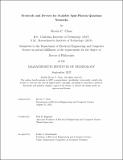Protocols and Devices for Scalable Spin-Photon Quantum Networks
Author(s)
Chen, Kevin C.
DownloadThesis PDF (16.06Mb)
Advisor
Englund, Dirk R.
Terms of use
Metadata
Show full item recordAbstract
One of the central goals in quantum information science is constructing a quantum network useful for quantum communication, sensing, and computation. Its realization crucially depends on efficient distribution of entanglement. A promising approach entails connecting quantum nodes via photons, which are naturally resilient against decoherence, and storing quantum bits in atomic memories; among which, solid state spin qubits in diamond are particularly promising candidates for memory storage in a quantum repeater network. However, experimental efforts thus far have been mainly stymied by the absence of efficient and scalable spin-photon interfaces.
To address these challenges, we propose a photonic integrated circuit architecture with heterogeneously integrated emitter-nanocavity systems for faithfully transferring photonic qubits onto diamond color centers. This hybrid platform offers arbitrary photonic routing, phase stability, and reconfigurability to achieve high-fidelity and high-efficiency local and remote entanglement generation. Subsequently, we report our experimental efforts in realizing a cavity-enhanced optical interface with tin vacancy centers in diamond and characterizing a heterogeneously integrated emitter cavity system in a silicon nitride photonic integrated circuit. The on-chip components allow for additional control over both the spin and optical degrees of freedom necessary for achieving spin photon entanglement. As an outlook, we discuss how the experimental results in this thesis and ongoing efforts pave the path towards additional quantum network applications, such as realizing a quantum random access memory.
Date issued
2023-09Department
Massachusetts Institute of Technology. Department of Electrical Engineering and Computer SciencePublisher
Massachusetts Institute of Technology